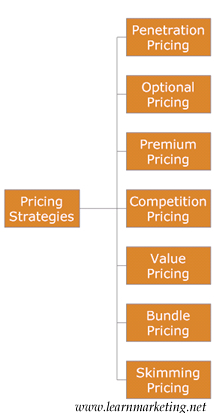I found this article on line. It gives and explanation for different pricing. This is one of the most important aspects of business. You have to be able to cover cost, and make a profit if you want your business to stay strong. You have to be ahead of other bussisness.
THE MARKETING MIX
PRICING STRATEGIES Mobile Edition Related Links: Pricing | Place | Promotion | Service Marketing Mix | Emarketing Mix
Introduction
Pricing is one of the most important elements of the marketing mix, as it is the only mix, which generates a turnover for the organisation. The remaining 3p’s are the variable cost for the organisation. It costs to produce and design a product, it costs to distribute a product and costs to promote it. Price must support these elements of the mix. Pricing is difficult and must reflect supply and demand relationship. Pricing a product too high or too low could mean a loss of sales for the organisation.
Pricing Factors
Pricing should take into account the following factors into account:
- Fixed and variable costs.
- Competition
- Company objectives
- Proposed positioning strategies.
- Target group and willingness to pay
An organisation can adopt a number of pricing strategies, the pricing strategy will usually be based on corporate objectives.
Types of Pricing Strategy
| | Pricing Strategy | Definition | Example | |
| Penetration Pricing | Here the organisation sets a low price to increase sales and market share. Once market share has been captured the firm may well then increase their price. | A television satellite company sets a low price to get subscribers then increases the price as their customer base increases. |
| Skimming Pricing | The organisation sets an initial high price and then slowly lowers the price to make the product available to a wider market. The objective is to skim profits of the market layer by layer. | A games console company reduces the price of their console over 5 years, charging a premium at launch and lowest price near the end of its life cycle. |
| Competition Pricing | Setting a price in comparison with competitors. Really a firm has three options and these are to price lower, price the same or price higher | Some firms offer a price matching service to match what their competitors are offering. |
| Product Line Pricing | Pricing different products within the same product range at different price points. | An example would be a DVD manufacturer offering different DVD recorders with different features at different prices eg A HD and non HD version.. The greater the features and the benefit obtained the greater the consumer will pay. This form of price discrimination assists the company in maximising turnover and profits. |
| Bundle Pricing | The organisation bundles a group of products at a reduced price. Common methods are buy one and get one free promotions or BOGOF's as they are now known. Within the UK some firms are now moving into the realms of buy one get two free can we call this BOGTF i wonder? | This strategy is very popular with supermarkets who often offer BOGOF strategies. |
| Psychological Pricing | The seller here will consider the psychology of price and the positioning of price within the market place | The seller will therefore charge 99p instead £1 or $199 instead of $200. The reason why this methods work, is because buyers will still say they purchased their product under £200 pounds or dollars, even thought it was a pound or dollar away. My favourite pricing strategy. |
| Premium Pricing | The price set is high to reflect the exclusiveness of the product. | An example of products using this strategy would be Harrods, first class airline services, Porsche etc. |
| Optional Pricing | The organisation sells optional extras along with the product to maximise its turnover. T | This strategy is used commonly within the car industry as i found out when purchasing my car. |
| Cost Based Pricing | The firms takes into account the cost of production and distribution, they then decide on a mark up which they would like for profit to come to their final pricing decision. | If a firm operates in a very volatile industry, where costs are changing regularly no set price can be set, therefore the firm will decide on their mark up to confirm their pricing decision. |
| Cost Plus Pricing | Here the firm add a percentage to costs as profit margin to come to their final pricing decisions. | For example it may cost £100 to produce a widget and the firm add 20% as a profit margin so the selling price would be £120.00 |

No comments:
Post a Comment